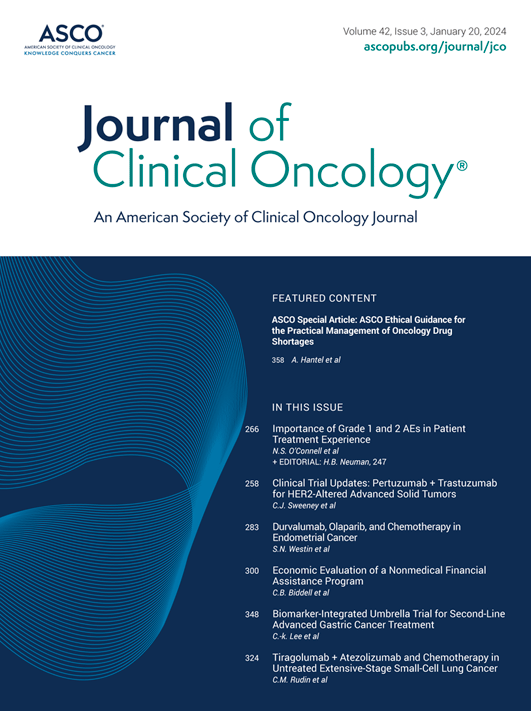Xevinapant或安慰剂加铂类放化疗治疗未切除的局部晚期头颈部鳞状细胞癌(TrilynX):一项随机III期研究
IF 41.9
1区 医学
Q1 ONCOLOGY
引用次数: 0
摘要
目的:trilynx是一项随机、双盲、III期研究,评估在未切除的局部晚期头颈部鳞状细胞癌(LA SCCHN)患者的放化疗(CRT)中添加xevinapant(一种凋亡蛋白抑制剂抑制剂)或安慰剂。方法未切除的LA SCCHN(口咽部[仅p16阴性]、下咽或喉部)患者随机按1:1分配至6个周期,口服xevinapant 200 mg/天或匹配的安慰剂(21天周期的第1-14天每天1次)+前3个周期的CRT(顺铂[100 mg/m2,每个周期的第2天1次]+调强放疗[70 Gy; 2 Gy/天35次,5天/周])。主要终点是由盲法独立审查委员会评估的无事件生存期(EFS)。无进展生存期、总生存期(OS)和安全性是次要终点。在2020年9月20日至2023年2月27日期间,730名患者被随机分配到xevinapant + CRT (n = 364)或安慰剂+ CRT (n = 366)组。xevinapant组EFS的中位(95% CI)为19.4个月(14.5至不可估计),安慰剂组为33.1个月(21.0至不可估计)(风险比[HR], 1.33 [95% CI, 1.05至1.67];P = .9919)。xevinapant组的OS更差(HR, 1.39 [95% CI, 1.04 ~ 1.86])。在320例(87.9%;xevinapant)和286例(80.3%;安慰剂)患者中发生了≥3级治疗不良事件(teae);贫血(78例[21.4%]vs 51例[14.3%])和中性粒细胞减少(71例[19.5%]vs 69例[19.4%])最为常见。严重teae发生在194例(53.3%;xevinapant)和129例(36.2%;安慰剂)患者中。teae导致死亡的患者分别为22例(6.0%;xevinapant)和13例(3.7%;安慰剂)。结论xevinapant加CRT不能改善未切除LA SCCHN患者的EFS (xevinapant比安慰剂的EFS更短),并且与安慰剂加CRT相比,安全性更差。本文章由计算机程序翻译,如有差异,请以英文原文为准。
Xevinapant or Placebo Plus Platinum-Based Chemoradiotherapy in Unresected Locally Advanced Squamous Cell Carcinoma of the Head and Neck (TrilynX): A Randomized, Phase III Study.
PURPOSE
TrilynX was a randomized, double-blind, phase III study evaluating the addition of xevinapant (an inhibitor of apoptosis proteins inhibitor) or placebo to chemoradiotherapy (CRT) in patients with unresected locally advanced squamous cell carcinoma of the head and neck (LA SCCHN).
METHODS
Patients with unresected LA SCCHN (oropharynx [p16-negative only], hypopharynx, or larynx) were randomly assigned 1:1 to six cycles of oral xevinapant 200 mg/day or matched placebo (once daily on Days 1-14 of a 21-day cycle) plus CRT for the first three cycles (cisplatin [100 mg/m2 once on Day 2 of every cycle] plus intensity-modulated radiotherapy [70 Gy; 35 fractions of 2 Gy/day, 5 days/week]). The primary end point was event-free survival (EFS) assessed by the blinded independent review committee. Progression-free survival, overall survival (OS), and safety were secondary end points.
RESULTS
Between September 20, 2020, and February 27, 2023, 730 patients were randomly assigned to xevinapant plus CRT (n = 364) or placebo plus CRT (n = 366). The median (95% CI) EFS was 19.4 months (14.5 to not estimable) with xevinapant and 33.1 months (21.0 to not estimable) with placebo (hazard ratio [HR], 1.33 [95% CI, 1.05 to 1.67]; P = .9919). OS was worse in the xevinapant arm (HR, 1.39 [95% CI, 1.04 to 1.86]). Grade ≥3 treatment-emergent adverse events (TEAEs) occurred in 320 (87.9%; xevinapant) and 286 (80.3%; placebo) patients; anemia (78 [21.4%] v 51 [14.3%]) and neutropenia (71 [19.5%] v 69 [19.4%]) were the most common. Serious TEAEs occurred in 194 (53.3%; xevinapant) and 129 (36.2%; placebo) patients. TEAEs leading to death occurred in 22 (6.0%; xevinapant) and 13 (3.7%; placebo) patients.
CONCLUSION
Xevinapant plus CRT did not improve EFS (EFS was shorter with xevinapant v placebo) and demonstrated an unfavorable safety profile versus placebo plus CRT in patients with unresected LA SCCHN.
求助全文
通过发布文献求助,成功后即可免费获取论文全文。
去求助
来源期刊

Journal of Clinical Oncology
医学-肿瘤学
CiteScore
41.20
自引率
2.20%
发文量
8215
审稿时长
2 months
期刊介绍:
The Journal of Clinical Oncology serves its readers as the single most credible, authoritative resource for disseminating significant clinical oncology research. In print and in electronic format, JCO strives to publish the highest quality articles dedicated to clinical research. Original Reports remain the focus of JCO, but this scientific communication is enhanced by appropriately selected Editorials, Commentaries, Reviews, and other work that relate to the care of patients with cancer.
 求助内容:
求助内容: 应助结果提醒方式:
应助结果提醒方式:


